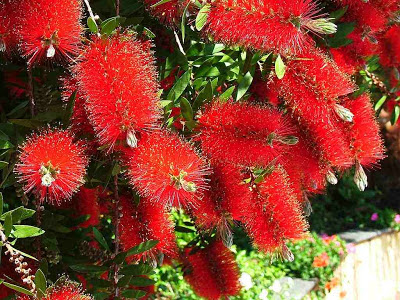Bottlebrush (Callistemon viminalis)
Arabic name: فرشاة الزجاج
The evergreen Bottlebrush (Callistemon viminalis) is an attractive weeping tree with slender flexible stems, and showy flowers blooming in late spring and early summer. The striking bright red flowers have long stamens and resemble bottlebrushes. Of the 25 species of Callistemon native to Australia, L. viminalis is the most widely cultivated. Although it grows along watercourses in its natural habitat, the bottlebrush can tolerate drought once established.
The Bottlebrush grows to a height of up to 6m, with a spread of 5m, and has a moderate growth rate of about 25cm per year.
Requirements:
The Bottlebrush grows in full sun. It thrives in well-drained soil but can tolerate poor drainage. Tolerates hot and dry conditions once established.
Water usage:
It requires some watering once established. Generally, trees need supplemental irrigation to get established, especially if planted after the rainy season. During the first year, irrigate in the amount of 20 – 25 liters of water twice a week. During its second year, a tree needs to be irrigated in the amount of 40 liters once a week. Beginning with the third year, trees usually get established, and some, like the Bottlebrush, need to be irrigated in the amount of 50 – 60 liters once a month.
Appearance:
This evergreen tree grows into a small willowy tree with weeping branches and a shrubby growth habit. Young foliage is reddish bronze, turning green with age. Leaves are up to 10cm long, narrow, lance-shaped and are a dullish green. Flowers have very small petals, but numerous long bright red stamens forming dense spikes arranged around the stems in 15cm long cylinders give it the distinctive bottlebrush shape.
Notes on use:
A specimen tree distinguished by its bright red flowers; good for patios and small spaces.
Propagation:
May be propagated from seeds and semi-hardwood cuttings in summer.
Maintenance:
Pruning the lower branches of the Bottlebrush will give it a more rounded look. May be fertilized annually after bloom.
Comments:
Over watering causes chlorosis (yellowing of leaves).
Image source: https://www.greenleafnursery.com
Image source: http://treesplanet.blogspot.com/
This article is part of a series of articles prepared by the Center for the Study of the Built Environment (CSBE) on water conserving landscapes.
For additional information on water conserving gardens, visit the CSBE web site at www.csbe.org
Support for the CSBE project on water conserving landscapes is provided by WEPIA (Water Efficiency and Public Information for Action), a program being implemented in collaboration with the Ministry of Water and Irrigation and funded by the United States Agency for International Development (USAID).


